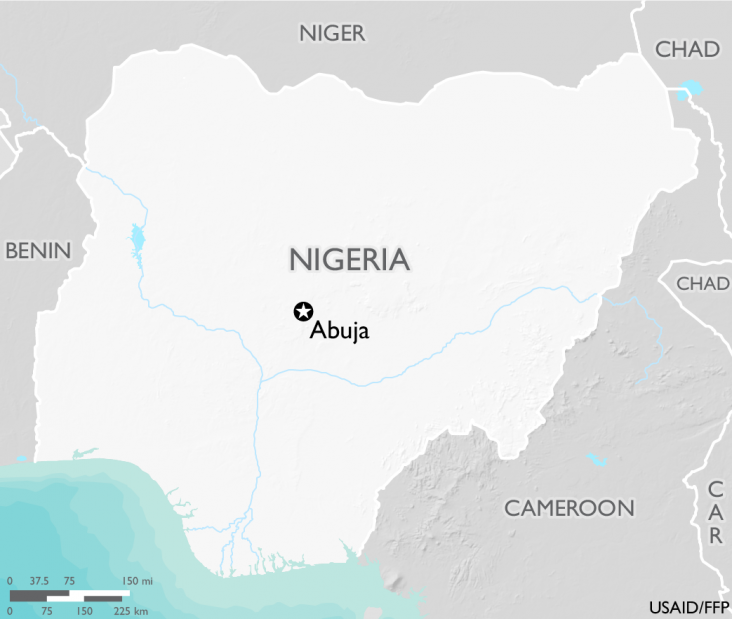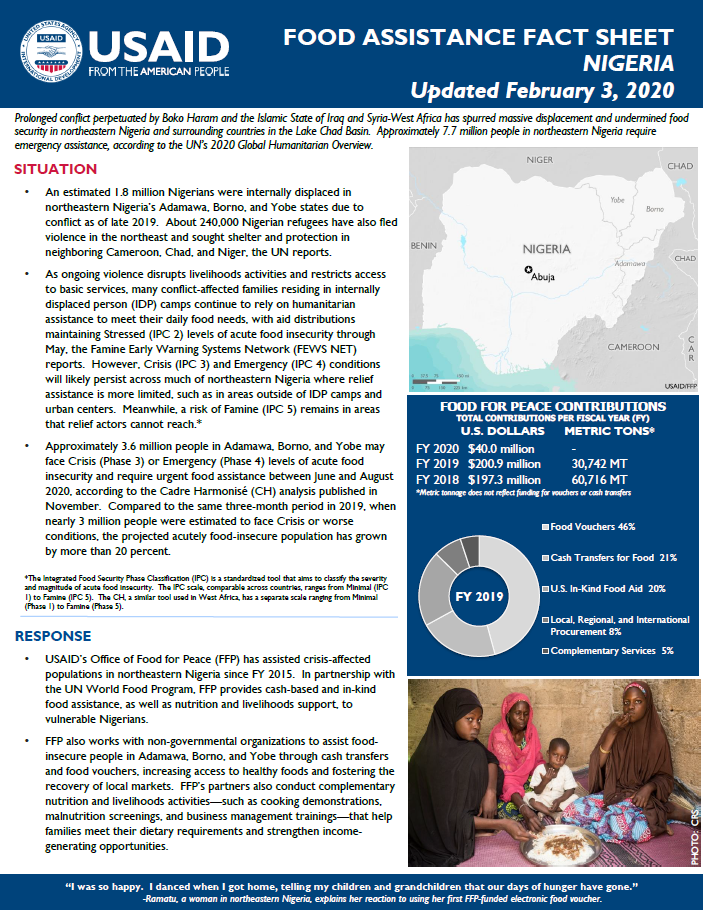- What We Do
- Agriculture and Food Security
- Democracy, Human Rights and Governance
- Economic Growth and Trade
- Education
- Environment and Global Climate Change
- Gender Equality and Women's Empowerment
- Global Health
- Humanitarian Assistance
- Transformation at USAID
- Water and Sanitation
- Working in Crises and Conflict
- U.S. Global Development Lab
Speeches Shim

February 3, 2020
Prolonged conflict perpetuated by Boko Haram and the Islamic State of Iraq and Syria-West Africa has spurred massive displacement and undermined food security in northeastern Nigeria and surrounding countries in the Lake Chad Basin. Approximately 7.7 million people in northeastern Nigeria require emergency assistance, according to the UN’s 2020 Global Humanitarian Overview.
Situation
- An estimated 1.8 million Nigerians were internally displaced in northeastern Nigeria’s Adamawa, Borno, and Yobe states due to conflict as of late 2019. About 240,000 Nigerian refugees have also fled violence in the northeast and sought shelter and protection in neighboring Cameroon, Chad and Niger, the UN reports.
- As ongoing violence disrupts livelihoods activities and restricts access to basic services, many conflict-affected families residing in internally displaced person (IDP) camps continue to rely on humanitarian assistance to meet their daily food needs, with aid distributions maintaining Stressed (IPC 2) levels of acute food insecurity through May, the Famine Early Warning Systems Network (FEWS NET) reports. However, Crisis (IPC 3) and Emergency (IPC 4) conditions will likely persist across much of northeastern Nigeria where relief assistance is more limited, such as in areas outside of IDP camps and urban centers. Meanwhile, a risk of Famine (IPC 5) persists in areas that relief actors cannot reach, where food security conditions are likely similar to, or worse than, outcomes in nearby accessible zones.
- Approximately 3.6 million people in Adamawa, Borno, and Yobe may face Crisis (Phase 3) or Emergency (Phase 4) levels of acute food insecurity and require urgent food assistance between June and August 2020, according to the Cadre Harmonisé (CH) analysis published in November. Compared to the same three-month period in 2019, when nearly 3 million people were estimated to face Crisis or worse conditions, the projected acutely food-insecure population has grown by more than 20 percent.
* The Integrated Phase Classification (IPC) is a standardized tool that aims to classify the severity and magnitude of food insecurity. The IPC scale, which is comparable across countries, ranges from Minimal (IPC 1) to Famine (IPC 5). The CH, a similar tool used in West Africa, has a separate scale ranging from Minimal (Phase 1) to Famine (Phase 5).
Food Assistance Fact Sheet - Nigeria ![]() (pdf - 232k)
(pdf - 232k)
Response
- USAID’s Office of Food for Peace (FFP) has assisted crisis-affected populations in northeastern Nigeria since FY 2015. In partnership with the UN World Food Program, FFP provides cash-based and in-kind food assistance, as well as nutrition and livelihoods support, to vulnerable Nigerians.
- FFP also works with non-governmental organizations to assist food-insecure people in Adamawa, Borno, and Yobe through cash transfers and food vouchers, increasing access to healthy foods and fostering the recovery of local markets. FFP’s partners also conduct complementary nutrition and livelihoods activities—such as cooking demonstrations, malnutrition screenings, and business management trainings—that help families meet their dietary requirements and strengthen income-generating opportunities.
Food for Peace Contributions
Total Contributions:
| Fiscal Year | U.S. Dollar | Metric Tons |
| FY 2020 | $40.0 million | ---- |
| FY 2019 | $200.9 million | 30,742 MT |
| FY 2018 | $197.3 million | 60,716 MT |
* Metric tonnage does not reflect funding for vouchers or cash transfers.
Related Resources:
- USAID/DCHA Lake Chad Basin Complex Emergency Fact Sheet
- Families in Nigeria Find Hope Away From Home: A Graphic Novel
- Electronic Food Vouchers Bring Relief to Vulnerable Nigerian Families


Comment
Make a general inquiry or suggest an improvement.